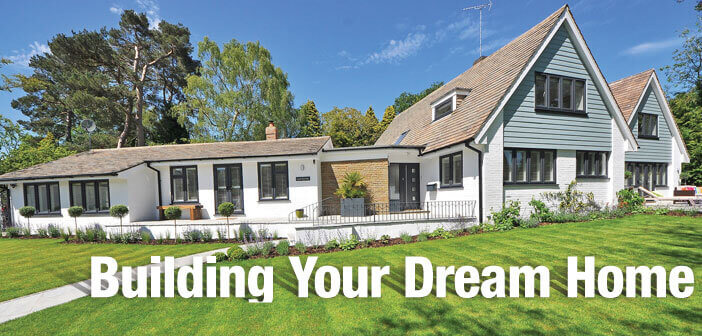Building Your Dream Home in Omaha, NE 2017
When it comes to investing in the perfect place to call home, there are two options on the table: build or buy. For those who decide to embark on the first path and build new, there will be many decisions to be made ahead. At the end of the process, the reward is a finished product that’s a direct reflection of the people who it was created for and who played an active part in helping to create it themselves. With everything completely customized based on the preferences of the homeowner, this is ideal for those who would rather plan for the construction of their own dream home instead of taking their chances on finding it while navigating the tides of the current real estate market (where it’s not uncommon for homes to be listed and sold on the same day).
{Builder Selection}
If you’re going to proceed with building a home, there’s a pretty good chance you’re going to enlist the services of a local home builder. While there are a limited number of other options one might consider depending on the circumstances, this is the most popular for a good reason. There’s already a process in place for everything that needs to happen along the timeline from start to finish, and you’re guided through it step by step.
There are production home builders and custom home builders in the area, and both are able to deliver quality homes. When deciding between the two options, it largely depends on how many choices you wish to make and how much design input you’d like to have during the construction process.
You might be asking yourself, “What’s the difference?” In short, it’s as follows:
Production builders are simultaneously building a community of homes based on a library of floor plans, each with a limited array of options to personalize the home.
Custom builders typically create one-of-a-kind homes, offering a wide range of design choices and with each built on a single lot.
With production builders, you’ll commonly find that the home and land are offered together as a bundled package. There is a range of house plans to choose from, and buyers are able to select their preferences in several key categories. Of the selection of homes on the menu, there are options priced for first-time, move-up, and luxury buyers.
Alternatively, with custom builders, it’s exactly like it sounds – everything about the home is built to the exact specifications of the buyer. Homes can be built on land you own or acquire, and you can supply a floorplan or commission one to be drawn up. You might choose to work with a separate architect or builder, or hire a company with design-build capabilities.
There are advantages associated with both, it’s just a matter of deciding which is best for you.
As far as the professional you choose to perform the job, general contractor or builder who is a teacher—who can educate on the sequence and steps necessary to make building a home happen—is definitely someone you want to work with on the project. It is wise to interview different builders and find one that you communicate well with, who is flexible and who is able to provide an accurate estimate of final cost. Most builders offer at minimum a one year warranty, and most have a clean-up crew that performs a final detail cleaning before the home is occupied as well as a crew that goes through the house and tests all lights, outlets, appliances, fireplaces, sprinklers, and so on to ensure proper operation. A good builder spells out his/her warranty, detailing exactly what is and is not covered. A booklet or workbook for the first-time homebuilder to use as a guide is also a very valuable resource.
{Financing}
When planning to build a home, you’ll not only be working closely with a builder/general contractor/subcontractors/etc. but also with an experienced lender who will lead you through the financing process each step of the way.
The process starts with getting pre-approved for long-term financing. Once that is in place, it’s a matter of having the discussion with the builder to determine who will be taking out the financing for the new construction and putting together a contract. If the builder takes out the construction loan, the banker will work to get the buyer approved for a purchase transaction once the house is completed. If the buyer/borrower takes out the construction loan, the banker will work with them during the construction process and get them prepared to have their long-term financing set up as soon as their house is built. Upon completion of the construction, the banker will ensure that long-term financing is in place and coordinate to pay off the construction loan.
At the start of the process during pre-qualification, the lender will look at the buyer’s credit, down payment, monthly obligations, income, etc. This will allow the financial institution to determine not only if they can get the client approved for financing, but even more importantly, to make sure that the client is comfortable with their new house payment obligation. This is essential since this monthly payment will likely be around for the next 15 to 30 years.
Mortgage rates continue to be relatively low, which benefits those building as well as buying. The most obvious advantage to building is that you are assured to get the floor plan and features you want. However, a compromise on location is common, as you may not be able to build in a neighborhood that is close to the area of town that you want to be in based on location near schools, work, shopping, friends and family, etc. As far as costs go, it can be more expensive to build than to buy, but not always. The initial costs for new construction may be higher, but you can expect minimal expenses when it comes to repairs, decorating, and general upkeep for an extended period of time. With an existing home, there will likely be the need for replacing the roof, windows, utilities, etc. With a newly built home, everything is built to current code, and therefore should be less expensive to heat and cool. Most people do not realize that Homeowners Insurance is typically less expensive on a newly built home as well.
Although construction loan rates will vary from one lender to another, usually the difference is minimal. Always keep in mind that the typical construction loan process is approximately six months long and during this period the customer only pays interest on the balance that has been drawn upon. Do not get overburdened with the construction loan itself–the bigger financial impact will come with the long-term financing. As such, look for a lender that has your best interests at hand for the long term.
{Realtor}
Although you’ll be in the capable hands of the professionals we’ve already mentioned, the purchase of a home that will be built especially for you often seems more complicated and intimidating than the purchase of an existing home listed on the market. Thus, it’s important to work with a real estate agent that’s experienced with the specifics of building a new home. Most builders will have an agent, or a team of agents, that represent them as the seller’s agent. However, it’s prudent for a buyer to enlist the services of an agent independent of the builder to represent them in the transaction. While the seller’s agent will be a great resource to utilize during the process, as they are the most knowledgeable about their client, a buyer’s agent is the one who will ultimately be responsible for looking after your best interests, because you are their client.
{Design Features}
When you build a house, you have the opportunity to select your favorite (fill in the blank) – you name it, there’s probably a host of options to pick from during the process of assembling the key components that will come together to form your dream home. If your budget allows, you can include every item on your wish list – i.e. three-car garage, drop zone, open floor plan, walk-in pantry – instead of settling for a home that may only have a few of those things.
Many are also choosing to build their new homes with outdoor living space, extending interior design to the home’s exterior features. Along with sizeable decks and patios, the addition of outdoor fireplaces, kitchens, and spaces designed for mounting a TV and integrating technology are now prevalent. As far as the key exterior features of a new home, not accounting for aspects of the property itself such as the installation of landscaping or outdoor entertaining areas, you’ll be deciding on the siding, roofing, windows and doors.
“Windows really accent the aesthetic of a new home while making it as energy efficient and secure as possible,” advises Jason Olberding of J-Tech Construction and J-Tech Solar. “Seamless siding has also become very popular here in Nebraska due to its durability and energy efficiency. We own our own siding machine, an investment that allows us to manufacture the siding on the job site. Our approach is to custom fit the home so there are no wasted materials and the client gets a first class product, and that’s not something you’ll commonly find with other siding companies here in the market. Also important to note regarding siding, although some products claim to be maintenance free, that is not always the case. I’d recommend going with a seamless metal alloy siding as opposed to vinyl or pre-painted cement board. This will prove to be a better investment down the road, and one that you will be thankful you made up-front.
Speaking of investments, a home is one of, if not the most, expensive things you’ll purchase in an entire lifetime. Make sure to do your research before entering any contracts, choose companies that are as dedicated to seeing your dreams come to life as you are, and stay involved during the process!”
Basically, when you build a new home, your home is personalized to your tastes and likes in every possible way, inside and out. It’s an opportunity most homeowners would love to have – so by all means, take advantage! Now that we’ve talked a little bit about the outside, let’s move on to the interior design.
Tile, for instance, is something that’s found in just about every home, but that will vary in each based on design preferences. It can be incorporated throughout an entire home or just in certain areas, and can be selected based on options available from your builder or can be completely customized.
“As a part of our core offerings at Modern Concepts Tile, we perform custom tilework during new home construction,” says Danny Reynolds of Modern Concepts Tile. “By trade, we are artists and craftsmen, so we are involved with both the design and installation of our custom projects. On the design end, we specialize in the selection of materials, sizes, finishes, and colors of tile to achieve unique or traditional patterns. Just as important, we are skilled and experienced when it comes to the appropriate techniques used for installation. Our work is commonly found in prominent, high-traffic or well-used areas of the home; kitchens, bathrooms, fireplaces in living areas, entryways and mud rooms, and flooring throughout. As such, the end result needs to be attractive but also functional and durable to stand the test of time and use.
While we have the ability to do all sorts of projects involving tile in a residential setting, we love those that challenge us to get creative and allow us to add in personalized touches for the homeowner. There is so much you can do with tile! If you’re looking for inspiration or suggestions, we’re happy to help, and we’ve certainly got a lot to offer.”
Mike Prendergast of Modern Concepts Tile further advises, “As far as trends go, in tilework, it’s all about ‘bigger and better’ – the tile is getting bigger and the choices are getting better. For flooring this is especially true – 12×24” tile is about as low as it goes anymore. You can even get thin porcelain tile as large as 8×10’. There are so many finishes to choose from, with wood plank tile still very much on-trend. It’s amazing how much it really does look like wood flooring; it still fools a lot of people even though it’s been around for a while now! Offering the beauty of wood with the durability of tile, it lasts much longer and doesn’t require as much regular upkeep. Neutrals – with or without a pop of color – are still dominating color palettes, with clean whites and greyscale being the most popular choices. Vertical designs are gaining popularity over horizontal, and different shapes of tile are being incorporated into mosaics, so the design is not limited by the use of squares. Overall, homes that are being built have more ‘WOW’ factor than ever before when it comes to incorporating custom tilework into any number of different features.
If you want to incorporate custom tilework into the plans when building a new home, I’d advise you to get that subcontractor involved early on in the process. At that point, there’s still the flexibility to make additions or changes to the design as needed, and it will also help with coordination of project timing and workflow later on down the line. We can provide plenty of recommendations for homeowners who want to add that ‘special something.’ Use of tile to elevate the design of a home provides more enjoyment of it for years to come, and we’d love the opportunity to show you what we can do!”
Also weighing in on what’s been popular for new home construction and residential projects as far as tile products go, Jason Tidblom of Ceramic Tileworks Center further advises, “Porcelain coverings for flooring really add aesthetic appeal to a home, but aside from that, demand is there because of its durability. When deciding on the finishes in your new home, keep in mind that investing quality and longevity of the materials used in high-traffic or well-used areas is important. Porcelain is widely considered to be the most durable flooring covering of the bunch, with many different styles available to achieve whatever look you’re going for with your interior design. Homeowners like porcelain tile because it is easy for them to maintain and both the quality and longevity is incredible. There are plenty of other good ones too; our extensive selection at Ceramic Tileworks Center features over 250,000 square feet of product in stock between tile and countertops. We make it easy for our customers to come in and check out all of the different options.”
He adds, “Although there are some good rules of thumb to follow, don’t be afraid to incorporate different ideas into your new home that aren’t necessarily considered common. Going with your gut will pay off in the end when you are living in a home that you’ve created based on your own tastes and preferences.”
{Technology}
The technology that’s available today for residential use is pretty amazing too, and there’s no shortage of options for integrating it into the plans for your new home.
When building a new home, with the capability to run wiring wherever necessary, it’s the ideal scenario for integrating technology. With the multitude of options for technology in the home, it is essential to bring in an electronics professional early on in the planning stage. Electronics and entertainment technology are no longer considered a part of the finishing touches like home décor and furniture. In order to look and function at its best, it must be planned early in the home’s conceptualization.
Having an electronics professional on board early will allow for collaboration with the other subcontractors during this design phase of the project, ensuring everything necessary is in place for the technology and its desired functions to be supported. That same professional who has been involved with the design will then be there to manage its implementation. We can help with planning wiring infrastructure, suggesting ways to aesthetically integrate technology, wireless network design, home automation, audio/video distribution, private theater design, motorized shading solutions – there’s so much potential with new home construction.
Smart homes are much more common, with technology becoming more accessible to all and as more residential applications are developed.
“Homeowners are definitely taking advantage of new, cutting-edge ‘smart home’ technology that improves the environment and living comfort, reduces energy consumption, and provides increased safety and security,” says Pat Killeen of Engineered Controls. “From the most state-of-the-art Wi-Fi enabled thermostats and zoning systems, to whole-house air cleaning systems, whole-house humidification and dehumidification systems, Zigbee and Z-Wave wired and wireless home security and video systems; it’s all quite impressive.
It’s no secret that heating and cooling account for the bulk of a home’s energy usage, and simply incorporating a programmable thermostat can make a big difference. Smart thermostats such as Honeywell’s Prestige Wi-Fi Smart Thermostat and the Ecobee3 allow the monitoring of temperatures at home from mobile devices and PCs. The thermostats monitor humidity and temperature and alter cooling cycles, resulting in energy- and money-saving opportunities.
Honeywell’s Total Connect Service provides a personalized web portal with mobile apps that allow the homeowner to stay connected to their home’s heating and cooling system as well as its security system from their smartphone, tablet or personal computer. With Total Connect, the homeowner can monitor and control their home at any time and from anywhere.
My advice to those interested in adding integrating technology into a new home is to make sure and do your research. There is plenty of information on the internet today that will make the average homeowner much more knowledgeable about what is available in the residential construction market than anyone realizes. It’s a great place to start, and then you are better able to articulate what you’re envisioning to the professionals so that everyone is on the same page. As previously mentioned, far too often we too are contacted by homeowners once they’ve already moved into their new house, only to find out that they did not get that they wanted. The moral of the story is to get involved, ask questions, know what you want, and know what you are getting BEFORE the decisions are made by everyone but you, the customer.”
{Safety}
There are a number of features that can be incorporated in the design of a new home for the safety of the future occupants who will live there. Today, it often goes hand-in-hand with the technology that’s incorporated into the home, although important enough to mention in its own right. Security systems and lighting, access points and privacy features, fire protection and detection of harmful gasses, and a designated area to take shelter in the event of severe weather are all worthy of consideration.
The rule of thumb is to spare no expense when it comes to the safety of your family. Luckily, because costs are a concern for anyone building a home regardless of the price point, there are options available to fit within any budget. Selections of these features should be done early to account for integration. If any sacrifices need to be made, you’ll be able to do so knowing that the essentials are in place for your peace of mind.
“A smoke detector is a staple in any home, and with advances in technology, it is now most often incorporated as part of a system as opposed to a standalone device,” advises Bob Sorensen of FireGuard. “If your house will have any appliances that use natural gas, an attached garage, or a fireplace, carbon monoxide detection should be a critical function of that system as well. Although almost everything that has to do with safety is supported by such amazing technology, another staple, the fire extinguisher, is one thing that hasn’t changed much with the times. It’s advised to keep one in the kitchen, and in homes with fireplaces, to keep a second one near that location in the home.”
As far as new trends in home building, Radon-Resistant New Construction (RRNC) is now being promoted by the Nebraska Radon Program (a division of State of Nebraska Health and Human Services). With high levels of Radon gas nearly everywhere in southeast Nebraska, it only makes sense when building to install RRNC into your home to minimize the health risk from this cancer-causing gas.
Installing RRNC during the building process is easy and inexpensive; it’s less costly than to retrofit a house later on down the line. RRNC methods include installing a vapor barrier under the floor and tying the tile drain system into a vent stack that exits the roof of the house. This creates a natural chimney effect to vent the soil gasses (including Radon gas) that may accumulate under your floor. In the event that Radon levels still happen to measure high, it is easy to install an electric fan on the vent stack in the attic space and convert the passive system to an active one. This also comes at a price that’s far less costly than installing a complete mitigation system.
The standards for uniformity on RRNC are still being ironed out, but the basic concepts are widely understood and agreed upon. Once built, it is wise to have your home tested for Radon gas every two years. As soil conditions change, it changes the pathways that Radon can enter your home.
{Insurance}
Prior to move-in day, once the home is complete of course, but in actuality, even before breaking ground on the empty lot where your new home will soon take shape, you’ll need to have homeowners insurance in place. Why? Liability coverage. In terms of risk, the biggest one involved with building a home is liability in the case of an accident on the construction site. A home insurance policy with the liability coverage option included will be in addition to the builder’s risk insurance policy, filling in any gaps that exist. It will also provide coverage in case of fire or storm damage, both of which are not exactly unlikely here in Nebraska.
While most home builders offer a warranty covering the home for an extended period of time, you’ll also want to check in with your insurance agent to review your current homeowner’s policy and update as needed.
{Moving}
Moving to a new home, while exciting, is a big undertaking, and the process can be nerve-racking at times. In the case of building a new home, the timeline can potentially be subject to change, affecting the plans you have in place for the moving process. Working with an experienced professional moving company that’s flexible and can help you navigate any issues that arise is incredibly helpful.
A common problem with new construction is an unplanned gap between when the homeowner has to be out of their current home and when the new home is complete and move-in ready. This results in one of two scenarios. Option number one, they have nowhere to go and must add in a trip to a storage facility while temporarily staying with family or friends. Option number two, they are forced to move their date, maybe even a number of times. That close to the scheduled appointment, there’s no guarantee that the new date needed will be available, so they may have to wait even longer before they are settled.
Building a home is very time consuming, tends to be stressful, and becomes more so on both accounts the closer it is to being finished. The more packing you can get done early will make the end process much more manageable. If you are packing yourself, the goal is to pack anything that isn’t furniture in a box. The more stackable items are, the more efficient your mover can be. The more efficient the process, the less it will cost you.
Moving can be a very involved process. Like any project, moving is usually way more work than is first anticipated. With a reputable and experienced full-service moving company like Two Men And A Truck, you’re able to do as much or as little as you like, and then leave the rest up to the professionals. When working with any moving company, always get an in-home estimate that can be explained and makes sense. An in-home estimate allows a professional to guide you on how to prepare, how soon to get started, and how to meet deadlines. Start early!
While this is by no means an exhaustive list of everything you’d want or need to know before you commit to building your dream home, it’s a great start. If you are or will soon be in the market for a new home, it’s advantageous to explore the options for both building and buying. If the perfect home isn’t out there, or it is but it’s not for sale, you can still make your dream a reality and build it from the ground up!







